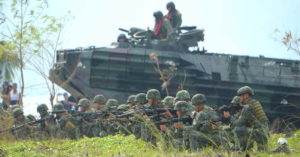APRIL 11, 2024 marked the launch of the first-ever trilateral alliance involving the United States, Japan and the Philippines. The trilateral summit hosted by US President Joe Biden was driven by strategic imperatives that underscore its pivotal role in realizing the US Indo-Pacific or Pivot to Asia strategy, acknowledging the region’s growing economic and military significance to US strategic interests.
The summit represents a crucial step for the US in advancing this strategy. For Japan, the trilateral pact is an opportunity to enhance its security role within the confines of its pacifist constitution.
Meanwhile, the Philippines seeks to counterbalance China’s territorial and maritime claims in the South China Sea (SCS) while relying on military support and aid from the US and Japan, which could be further materialized through the newly formed trilateral alliance.
As expected, during the summit, Biden reiterated the so-called ironclad US alliance commitment to the Philippines under their Mutual Defense Treaty, extending to armed attacks on Philippine armed forces, public vessels or aircraft — to include those of its coast guard — in the Pacific, including anywhere in the SCS.
The tripartite summit also launched the Japan-Philippines-US Balikatan 2025 (military exercises), underscoring the deepening defense and military cooperation among the three countries. This initiative builds upon recent joint naval training and exercises, such as the recently concluded joint naval exercises between Japan, the Philippines, the US and Australia in the contested waters of the SCS. Additionally, the summit also yielded plans for maritime training activity around Japan in 2025.
Furthermore, the revision of Japan’s Three Principles on the transfer of defense equipment and technology and its implementation guidelines, welcomed by the US and the Philippines, promises strengthened cooperation through joint development and production to bolster the three countries’ regional deterrence capabilities. The growing defense partnerships between Australia and the Philippines and between the Philippines and the Republic of Korea were also acknowledged and welcomed during the summit.
Also, the trilateral summit emphasized the collective commitment to a rules-based Indo-Pacific region. This commitment extends to collaborative efforts with other frameworks such as the Quad (Quadrilateral Security Dialogue), Aukus (Australia, the United Kingdom and the United States) and the US-Japan-Republic of Korea trilateral framework, reflecting a US-led and US-centric security architecture in the Asia-Pacific region. The summit also discussed increasing cooperation on various fronts, including economic security, clean energy, climate change and a shared commitment to uphold the July 12, 2016 arbitral award on the SCS.
Amid the worsening tensions in the SCS between the Philippines and China, it is imperative to ask what the implications of such a trilateral defense pact are for regional peace and security. How would other Southeast Asian countries react to this newly formed trilateral alliance, and are there real benefits? Is the tripartite alliance a precursor to creating an Asia-Pacific NATO (North Atlantic Treaty Organization)?
Hindsight
The formation of a trilateral defense alliance between the US, Japan and the Philippines has ignited significant geopolitical dynamics in the Asia-Pacific region. This alliance, focused on enhancing military cooperation and fortifying defense strategies, is widely perceived as a key component of the US’ China containment strategy outlined in the Indo-Pacific or Pivot to Asia policy. This strategy comes against the backdrop of China’s peaceful rise and its expanding political, diplomatic and economic clout in the Asia-Pacific region.
Establishing a trilateral defense pact between the three countries marks a significant strategic evolution toward a more aggressive and confrontational stance in international affairs, reminiscent of the Cold War era. This alliance reflects a concerted effort by the US to maintain its hegemonic status and strategic influence in the Asia-Pacific region while seeking to exert some degree of control over regional dynamics.
It also underscores a collective determination to strategically confront, encircle, isolate and diplomatically counter and contain China. It underscores the increasingly competitive geopolitical landscape shaped by the intensifying rivalry and competition between the US and China in the Asia-Pacific theater.
The formation of a trilateral alliance among the US, Japan and the Philippines holds the potential to introduce significant shifts in the regional geopolitics of Asia. While ostensibly aimed at strengthening security and economic cooperation among the involved parties, such an alliance may inadvertently exacerbate geopolitical tensions, particularly concerning other Asian countries, notably China.
The prospect of such a trilateral pact is inherently provocative, carrying the risk of igniting a regional arms race and fostering a competitive escalation in military capabilities. Moreover, it could strain diplomatic relations, prompt reciprocal military posturing and signal an escalation in the broader geopolitical rivalry and competition among major powers in the region.
This scenario could lead to a heightened polarization of the regional environment, placing additional strains on the delicate balance of power in Asia-Pacific. Such developments raise legitimate concerns regarding increased militarization and its potential implications for long-term regional peace and security.
In essence, the trilateral alliance among the US, Japan and the Philippines presents a complex dynamic in regional geopolitics, offering limited benefits to other countries in the Asia-Pacific. Its exclusivity poses a dual challenge, as it may inadvertently foster discord and polarization among regional countries.
This exclusivity could divide countries into factions aligned either with China’s interests or with the strategic imperative of the US, leading to diplomatic rifts and a heightened sense of competition. Consequently, this realignment not only risks deepening diplomatic divides but also has the potential to intensify competitive behaviors as countries navigate the evolving and volatile regional security landscape.
Also, establishing a trilateral security, defense and military alliance among the US, Japan and the Philippines raises concerns about potential unforeseen consequences that may introduce new regional security challenges and dilemmas. For Asean (Association of Southeast Asian Nations), a cornerstone of regional diplomacy, this development threatens the delicate balance of power in the region. It could undermine Asean’s centrality and pivotal role in navigating and resolving regional security issues.
Parallels to NATO
Furthermore, by drawing parallels to NATO, the trilateral alliance between the US, Japan and the Philippines prompts reflections on its potential trajectory and evolution. The strategic framework unfolding through this alliance, in conjunction and alongside US-led geocentric security frameworks such as the Quad, Auks and the US-Japan-Republic of Korea trilateral framework, signifies a concerted endeavor to establish a US-centric security architecture spanning the breadth of the Indo-Pacific region.
This network of defense and military alliances, with its focal point on the US, bears conceptual similarities to the structure of NATO. It serves a dual purpose: enhancing collaborative military/defense capabilities across the Pacific and Indian Oceans while implicitly aiming to counterbalance and contain China’s peaceful rise. Through these interconnected partnerships, a narrative of collective defense and security is beginning to take shape.
While the trilateral alliance has yet to formally adopt a doctrine akin to NATO’s Article 5, which asserts that an attack on one member is an attack on all, the underlying principle of mutual defense is unmistakable.
Conclusion
As far as the Philippines is concerned, if it truly wants peace and security in the region, it should pursue a path toward a secure and peaceful regional environment that does not involve the proliferation of military, and defense pacts and alliances but rather the commitment to diplomatic engagement, mutual respect and the unwavering pursuit of peace, economic prosperity, harmony and the preservation of its national sovereignty.
It is only by embracing a comprehensive and introspective strategy that the genuine interests of the Philippines and its neighboring nations can be safeguarded. History repeatedly illustrates that the most enduring security and prosperity stem from peaceful cooperation rather than confrontation and definitely not through preparing for war.
Source: The Manila Times
https://www.manilatimes.net/2024/04/13/opinion/columns/emerging-nato-in-the-east/1941099



